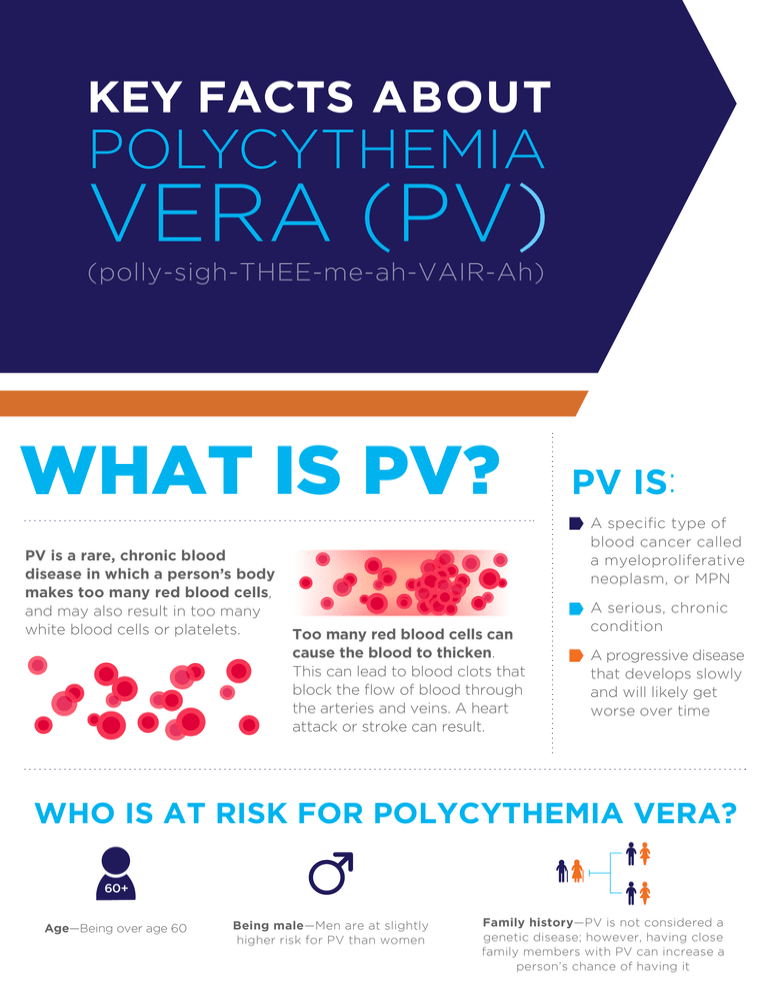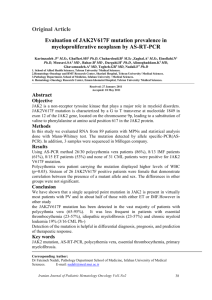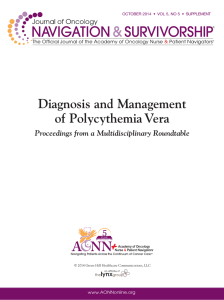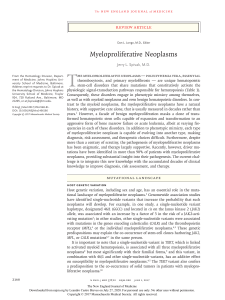
KEY FACTS ABOUT
POLYCYTHEMIA
VERA (PV)
(polly-sigh-THEE-me-ah-VAIR-Ah)
WHAT IS PV?
PV is a rare, chronic blood
disease in which a person’s body
makes too many red blood cells,
and may also result in too many
white blood cells or platelets.
Too many red blood cells can
cause the blood to thicken.
This can lead to blood clots that
block the flow of blood through
the arteries and veins. A heart
attack or stroke can result.
PV IS:
•
A specific type of
blood cancer called
a myeloproliferative
neoplasm, or MPN
•
A serious, chronic
condition
•
A progressive disease
that develops slowly
and will likely get
worse over time
WHO IS AT RISK FOR POLYCYTHEMIA VERA?
60+
Age—Being over age 60
Being male—Men are at slightly
higher risk for PV than women
Family history—PV is not considered a
genetic disease; however, having close
family members with PV can increase a
person’s chance of having it
HOW COMMON IS PV?
Only about
100,000
200,000
people in the U.S.
currently have PV
The National Institutes of Health
(NIH) defines a rare disease as one
that affects fewer than 200,000
individuals in the United States. To
date, the NIH has identified about
7,000 rare diseases.
AGE:
0-19
20-39 40-59
PV is uncommon in
people under age 30
60+
PV is most common in people older than 60,
although it may occur at any age
WHAT CAUSES PV?
The main cause of PV is a genetic mutation—or change—expressed in a bone
marrow cell in the body which results in an overproduction of blood cells
JAK2
JAK2
Mutation
JAK2 MUTATION
95% of people with PV have a specific mutation of the JAK2
(Janus kinase 2) gene
WHAT ARE THE SIGNS
AND SYMPTOMS OF PV?
Shortness of breath
Headache
Abdominal pain/discomfort
Double or blurred vision
Early feeling of
fullness when eating
Itching/pruritus
Reddening of the face
or a burning feeling on
the skin
Pain under the left ribs
Day or night sweats
Problems concentrating
Angina (chest pain)
Numbness in hands/feet
Bone pain
Fatigue (extreme
tiredness)
Dizziness, vertigo,
lightheadedness
Ringing in ears
Insomnia
BETWEEN
30%-40%
of PV patients present with
an enlarged spleen
Some symptoms are caused by thickening
of the blood, which results in a lack of oxygen
to parts of the body
WHAT OTHER HEALTH PROBLEMS CAN PV CAUSE?
ABOUT
Blood clots leading to
heart attack or stroke
Stomach ulcers, gout,
or kidney stones
Angina (chest pain)
Progression to
leukemia
10%
OF PEOPLE
PV
may progress
to myelofibrosis
or MF over
10 years
MF
HOW IS PV
DIAGNOSED?
WHAT IS THE
PROGNOSIS?
With PV, early diagnosis is important.
If your doctor suspects you have PV,
a blood test can aid in the diagnosis
Although not curable, PV can be managed
effectively over the course of the disease
In people with PV, the
median survival approaches
or exceeds 20 years.
ABOUT
OF PV CASES ARE DIAGNOSED AFTER
A CARDIOVASCULAR EVENT SUCH
AS A HEART ATTACK OR STROKE
Each person’s risk factors should be
evaluated individually
HOW IS PV MONITORED?
Healthcare Professionals monitor PV with periodic blood tests. They also
track the symptoms of PV. Regular monitoring and medical care can help
detect any changes in the condition. New or worsening symptoms should
be reported to a Healthcare Professional.
If you are affected by PV, your symptoms,
blood counts, even your feelings can help
you identify your PV State of Mine—or
where you are on your journey with PV.
WHAT IS YOUR
®
PV STATE OF MINE?
To learn more, visit
www.VoicesofMPN.com
Voices of MPN is a registered trademark of Incyte Corporation.
© 2015, Incyte Corporation. All rights reserved. UPM-1014 08/15







